Pump Handbook by Igor J. Karassik, Joseph P. Messina, Paul Cooper, Charles C. Heald - 3rd edition
Подождите немного. Документ загружается.

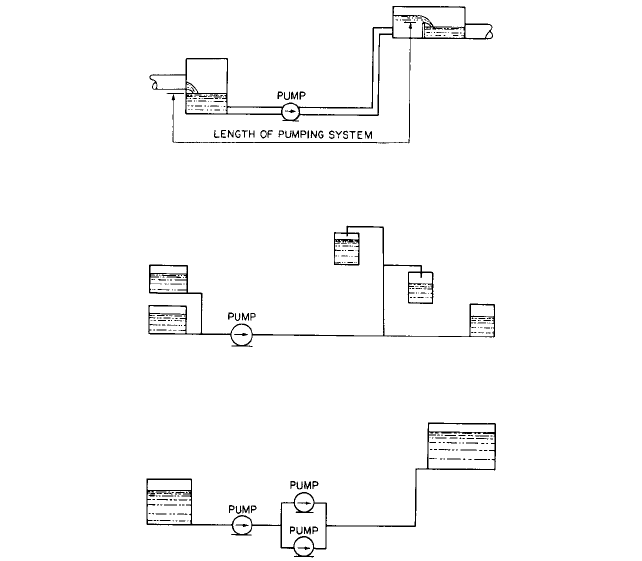
8.4 CHAPTER EIGHT
FIGURE 1 Length of system controlled by pump
FIGURE 2 Branch-line pumping system
FIGURE 3 Pumps in series and in parallel
action of the pump is considered part of the system. A pump and the limit of its system
length are shown in Figure 1.
The pump suction and discharge piping can consist of branch lines, as shown in Fig-
ure 2. There can be more than one pump in a pumping system. Several pumps can be
piped together in series or in parallel or both, as shown in Figure 3. When there is more
than one pump, the flow through the system is determined by the combined perfor-
mance of all the pumps.
The system through which the liquid is pumped offers resistance to flow for several
reasons. Flow through pipes is impeded by friction. If the liquid discharges to a higher ele-
vation or a higher pressure, additional resistance is encountered. The pump must there-
fore overcome the total system resistance due to friction and, as required, produce an
increase in elevation or pressure at the desired rate of flow. System requirements may be
such that the pump discharges to a lower elevation or pressure but additional pump head
is still required to overcome pipe friction and obtain the desired rate of flow.
ENERGY IN AN INCOMPRESSIBLE LIQUID _______________________________
The work done by a pump is the difference between the energy level at the point where the
liquid leaves the pump and the energy level at the point where the liquid enters the pump.
Work is also the amount of energy added to the liquid in the system. The total energy at
any point in a pumping system is a relative term and is measured relative to some arbi-
trarily selected datum plane.

8.1 PUMPING SYSTEMS AND SYSTEM-HEAD CURRVES 8.5
An incompressible liquid can have energy in the form of velocity, pressure, or elevation.
Energy in various forms is added to the liquid as it passes through the pump, and the total
energy added is constantly increasing with flow. It is appropriate then to speak of
the energy added by a pump as the energy added per unit of weight (force) of the liquid
pumped, and the units of energy expressed this way are foot-pounds per pound (newton-
meters per newton) or just feet (meters). Therefore, when adding together the energies in
their various forms at some point, it is necessary to express each quantity in common
equivalent units of feet (meters) of head.
Liquid flowing in a conduit can undergo changes in energy form. Bernoulli’s theorem
for an incompressible liquid states that in steady flow, without losses, the energy at any
point in the conduit is the sum of the velocity head, pressure head, and elevation head and
that this sum is constant along a streamline in the conduit. Therefore, the energy at any
point in the system relative to a selected datum plane is
(1)
where H energy (total head) of system, ft lb/lb or ft (N m/N or m)
V velocity, ft/s (m/s)
g acceleration of gravity, 32.17 ft/s
2
(9.807 m/s
2
)
p pressure, lb/ft
2
(N/m
2
)
g specific weight (force) of liquid, lb/ft
3
(N/m
3
)
Z elevation above () or below (
—
) datum plane, ft (m)
The velocity and pressure at the point of energy measurement are expressed in units
of equivalent head and are added to the distance Z that this point is above or below the
selected datum plane. If pressure is measured as gage (relative to atmosphere), total head
H is gage; if pressure is measured as absolute, total head H is absolute. Equation 1 can
also be applied to liquid at rest in a vertical column or in a large vessel (or to liquids of var-
ious densities) to account for changes in pressure with changes in elevation or vice versa.
The equivalent of velocity and pressure energy heads in feet (meters) can be thought
of as the height to which a vessel of liquid of constant density has to be filled, above the
point of measurement, to create this same velocity or pressure. This is illustrated in Fig-
ure 4 and further explained in the following text.
Velocity Head The kinetic energy in a mass of flowing liquid is mV
2
or (W/g)V
2
. The
kinetic energy per unit weight (force) of this liquid is (WV
2
/Wg), or V
2
/2g, measured in
feet (meters). This quantity is theoretically equal to the equivalent static head of liquid
that is required in a vessel above an opening if the discharge is to have a velocity equal
to V. This is also the theoretical height the jet of liquid would rise if it were discharging
vertically upward from an orifice.
A free-falling particle in a vacuum acquires the velocity V starting from rest after
falling a distance H. Also
All liquid particles moving with the same velocity have the same velocity head, regard-
less of specific weight. The velocity of liquid in pipes and open channels invariably varies
across any one section of the conduit. However, when calculating system resistance it is
sufficiently accurate to use the average velocity, computed by dividing the flow rate by the
cross-sectional area of the conduit, when substituting in the term V
2
/2g.
Pressure Head The pressure head, or flow work, in a liquid is p/g, with units in feet
(meters). A liquid, having pressure, is capable of doing work, for example, on a piston hav-
ing an area A and stroke L. The quantity of liquid required to complete one stroke is gAL.
The work (force stroke) per unit weight (force) is pAL/gAL, or p/g. The work a pump
V 22gH
1
2
1
2
1
2
H
V
2
2g
p
g
Z
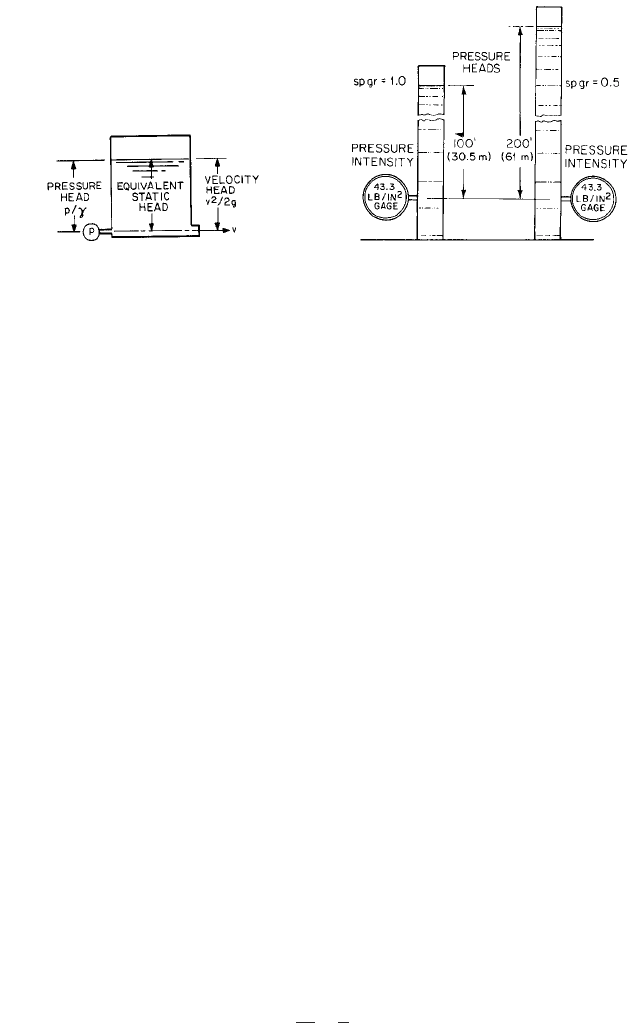
8.6 CHAPTER EIGHT
FIGURE 4 Equivalent static head
FIGURE 5 Liquids of different specific weights (also
specific gravities) require different column heights or
pressure heads to produce the same pressure intensity
(43.3 lb/in
2
298.5 kPa).
must do to produce pressure intensity in liquids having different specific weights varies
inversely with the specific weight or specific gravity of the liquid. Figure 5 illustrates this
point for liquids having specific gravities of 1.0 and 0.5. The less dense liquid must be
raised to a higher column height to produce the same pressure as the denser liquid. The
pressure at the bottom of each liquid column H is the weight of the liquid above the point
of pressure measurement divided by the cross-sectional area A at the same point, AHg/A,
which is simply Hg. Note that in this discussion A is in square feet (square meters) and
L and H are in feet (meters).
The height of the liquid column in feet (meters) above the point of pressure measure-
ment, if the column is of constant density, is equivalent pressure static head. When pres-
sure intensity AHg/A is substituted for p in p/g, it can be seen that the pressure head H is
the liquid column height. Therefore, at the base of equal columns containing different liq-
uids (with equal surface pressures), the pressure heads in feet (meters) are the same but
the intensities in pounds per square foot (newtons per square meter) are different. For this
reason, it is necessary to identify the liquids when comparing pressure heads.
Elevation Head The elevation energy, or potential energy, in a liquid is the distance Z
in feet (meters) measured vertically above or below an arbitrarily selected horizontal
datum plane. Liquid above a reference datum plane has positive potential energy because
it can fall a distance Z and acquire kinetic energy or vertical head equal to Z. Also, it
requires WZ ft lb (N m) of work to raise W lb (N) of liquid above the datum plane. The
work per unit weight (force) of liquid is therefore WZ/W, or Z ft (m). In a pumping system,
the energy required to raise a liquid above a reference datum plane can be thought of as
being provided by a pump located at the datum elevation and producing a pressure that
will support the total weight of the liquid in a pipe between the pump discharge and the
point in the pipe to which the liquid is to be raised. This pressure is AZg/A, or simply Zg
lb/ft
2
(N/m
2
) or Zy/144 lb/in
2
. Because head is equal to pressure divided by specific weight,
elevation head is Zg/g, or Z ft.
Liquid below the reference datum plane has negative elevation head.
Total Head Figure 6 illustrates a liquid under pressure in a pipe.To determine the total
head at the pressure gage connection and relative to the datum plane, Eq. 1 may be used
(assume that the gage is at the pipe centerline):
H
V
2
2g
p
g
Z
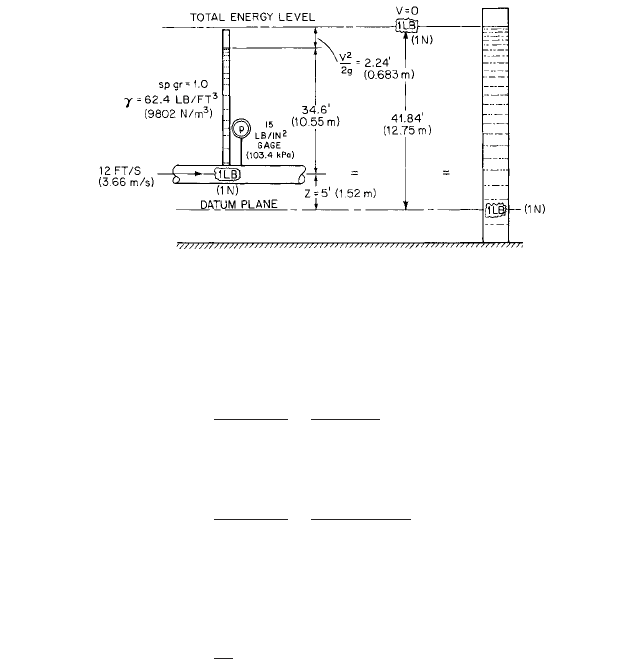
8.1 PUMPING SYSTEMS AND SYSTEM-HEAD CURRVES 8.7
FIGURE 6 The total head, or energy, in foot-pounds per pound (newtonmeters per newton) is equal to the sum of
the velocity, pressure, and elevation heads relative to a datum place. A unit weight (force) of the same liquid or any
liquid raised to rest at the height shown, or under a column of liquid of this same height, has the same head as the
unit weight (force) of liquid shown flowing in the pipe.
In USCS units
In SI units
The total head may also be calculated using the expression
In USCS units
In SI units
The total head of 41.84 ft (12.75 m) is equivalent to 1 lb (N) of the liquid raised 41.48 ft
(12.75 m) above the datum plane (zero velocity) or the pressure head of 1 lb (N) of the liq-
uid under a column height of 41.84 ft (12.75 m) measured at the datum plane.
The gage pressure p, and consequently the pressure head, are measured relative to
atmospheric pressure. Gage pressure head can therefore be a positive or a negative quan-
tity. The pressure may also be expressed as an absolute pressure (measured from complete
vacuum). Therefore, when velocity, pressure, and elevation heads are combined to obtain
the total energy at a point, it should be clearly stated that the total head is either feet
(meters) gage or feet (meters) absolute with respect to the datum plane.
The pressure or velocity of a liquid may at times be given as a pressure head of a liq-
uid having a density different from the density of the liquid being pumped. In the total
head, that is, the sum of the pressure, velocity, and elevation heads, the components must
be corrected to be equal to the head of the liquid being pumped. For example, if the pres-
sure is measured by a manometer to be 24 in (61 cm) of mercury (sp. gr. 13.6) absolute,
12.75 N
#
m>N, or m
H 0.683 10.55 1.52
41.84 ft
#
lb>lb, or ft
H 2.24 34.6 5
H
V
2
2g
manometer height Z
12.75 Nm>N, or m
0.683 10.55 1.52
H
3.66
2
2 9.807
103.4 1000
9802
1.52
41.84 ftlb>lb, or ft
2.24 34.6 5
H
12
2
2 32.17
144 15
62.4
5
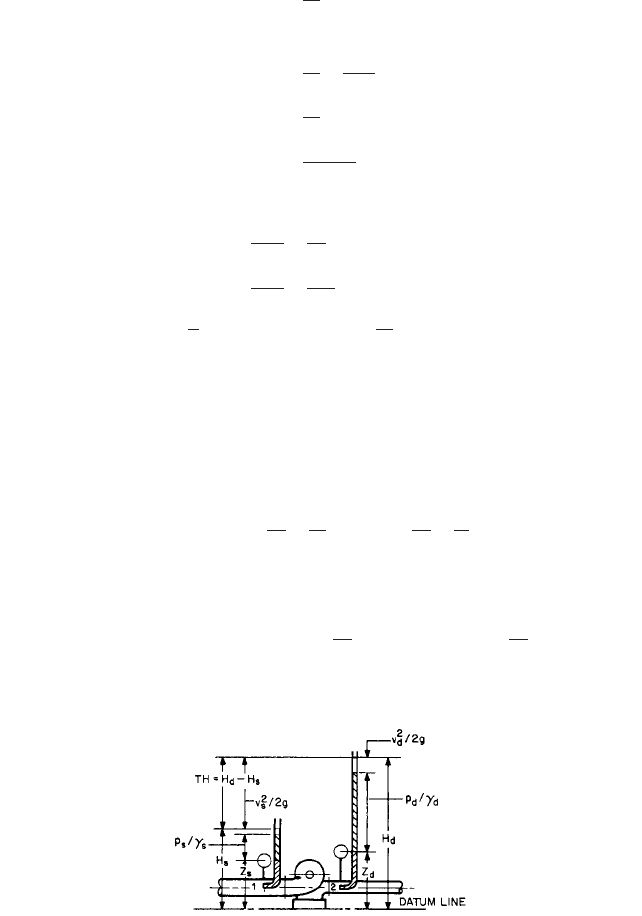
8.8 CHAPTER EIGHT
FIGURE 7 Centrifugal pump total head
the pressure head, or energy, in foot-pounds per pound (newton-meters per newton) of
water pumped at 60°F (15.6°C) is found as follows.
Let subscripts 1 and 2 denote different liquids or, in this example, mercury and water,
respectively:
(2)
(3)
Therefore
in USCS units
in SI units
Also, h
2
(27.2
—
13.6)( ) 6.8 ft [(8.3 13.6)( ) 2.04 m] gage if corrected to a
standard barometer of 30 in (76 cm) of mercury.
PUMP TOTAL HEAD___________________________________________________
The total head of a pump is the difference between the energy level at the pump discharge
(point 2) and that at the pump suction (point 1), as shown in Figures 7 and 8. Applying
Bernoulli’s equation (Eq. 1) at each point, the pump total head TH in feet (meters) becomes
(4)
The equation for pump differential pressure P
in pounds per square foot (newtons per
square meter) is
(5)
P
¢
in lb>in
2
P
¢
in lb>ft
2
144
P
¢
P
d
P
s
cp
d
g
d
aZ
d
V
2
d
2g
bd cp
s
g
s
aZ
s
V
2
s
2g
bd
TH H
d
H
s
a
V
2
d
2g
p
d
g
d
Z
d
b a
V
2
s
2g
p
s
g
s
Z
s
b
76
100
30
12
h
2
13.6
1
61
100
8.3 m abs
h
2
13.6
1
24
12
27.2 ft abs
sp. gr.
1
sp. gr.
2
h
1
g
1
g
1
h
1
h
2
p
2
g
2
h
1
g
2
g
2
p
1
h
1
g
1
p
2
h
1
p
1
g
1
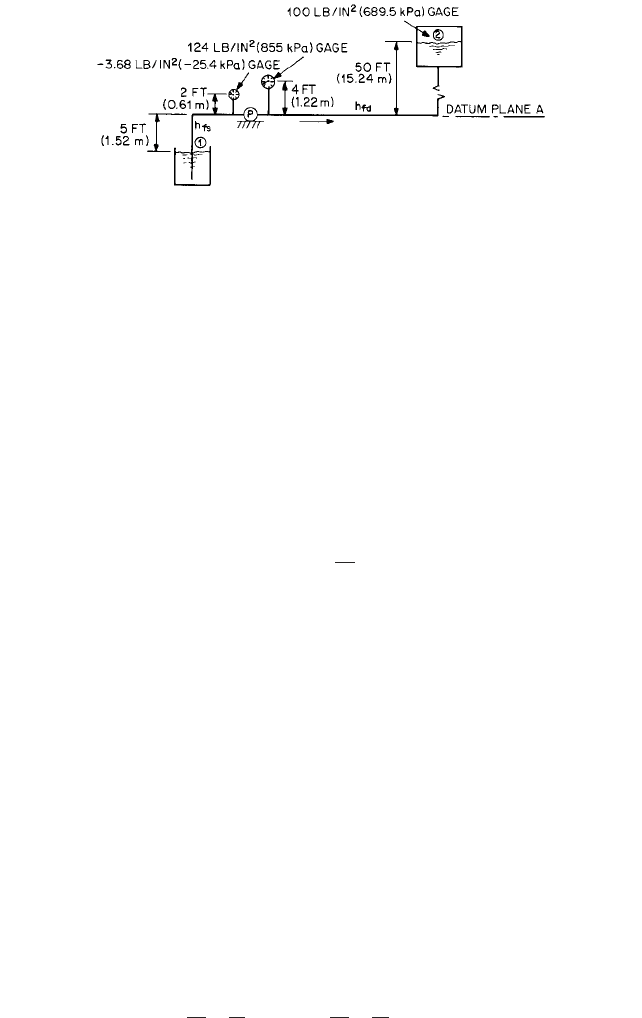
8.1 PUMPING SYSTEMS AND SYSTEM-HEAD CURRVES 8.9
FIGURE 8 Example 1
where the subscripts d and s denote discharge and suction, respectively, and
H total head of system, () or (
—
) ft (m) gage or () ft (m) abs
P total pressure of system, () or (
—
) lb/ft
2
(N/m
2
) gage or () lb/ft
2
(N/m
2
) abs
V velocity, ft/s (m/s)
p pressure, () or (
—
) lb/ft
2
(N/m
2
) gage or () lb/ft
2
(N/m
2
) abs
Z elevation above () or below (
—
) datum plane, ft (m)
g specific weight (force) of liquid, lb/ft
3
(N/m
3
)
g acceleration of gravity, 32.17 ft/s
2
(9.807 m/s
2
)
Pump total head TH and pump differential pressure P
are always absolute quantities
because either gage pressures or absolute pressures but not both are used at the discharge
and suction connections of the pump and a common datum plane is selected.
Pump total head in feet (meters) and pump differential pressure in pounds per square
foot (newtons per square meter) are related to each other as
(6)
It is very important to note that, if the rated total head of a centrifugal pump is given
in feet (meters), this head can be imparted to all individual liquids pumped at the rated
capacity and speed, regardless of the specific weight (force) of the liquids as long as their
viscosities are approximately the same. A pump handling different liquids of approxi-
mately the same viscosity will generate the same total head but will not produce the same
differential pressure, nor will the power required to drive the pump be the same. On the
other hand, a centrifugal pump rated in pressure units would have to have a different
pressure rating for each liquid of different specific weight (force). In this section, pump
total head will be expressed in feet (meters), the usual way of rating centrifugal pumps.
For an explanation of positive displacement pump differential pressure, its use and rela-
tionship to pump total head, see Chapter 3.
Pump total head can be measured by installing gages at the pump suction and dis-
charge connections and then substituting these gage readings into Eq. 4. Pump total head
may also be found by measuring the energy difference between any two points in the
pumping system, one on each side of the pump, providing all losses (other than pump
losses) between these points are credited to the pump and added to the energy head dif-
ference. Therefore, between any two points in a pumping system where the energy is
added only by the pump and the specific weight (force) of the liquid does not change (for
example, as a result of temperature), the following general equation for determining pump
total head applies:
(7) a
V
2
2
2g
p
2
g
Z
2
b a
V
2
1
2g
p
1
g
Z
1
b h
f 1122
TH 1H
2
H
1
2 h
f 1122
TH
P
¢
g

8.10 CHAPTER EIGHT
where the subscripts 1 and 2 denote points in the pumping system anyplace upstream and
downstream from the pump, respectively, and
H total head of system, () or (
—
) ft (m) gage or () ft (m) abs
V velocity, ft/s (m/s)
p pressure, () or (
—
) lb/in
2
(N/m
2
) gage or () lb/in
2
(N/m
2
) abs
Z elevation above () or below (
—
) datum plane, ft (m)
g specific weight (force) of liquid (assumed the same between points), lb/ft
3
(N/m
3
)
g acceleration of gravity, 32.17 ft/s
2
(9.807 m/s
2
)
h
f
sum of piping losses between points, ft (m)
When the specific gravity of the liquid is known, the pressure head may be calculated
from the following relationships:
In feet (8a)
In meters (8b)
The velocity in a pipe may be calculated as follows:
In feet per second (9a)
In meters per second (9b)
The following example illustrates the use of Eqs.4 and 7 for determining pump total head.
EXAMPLE 1 A centrifugal pump delivers 1000 gpm (227 m
3
/hr) of liquid of specific
gravity 0.8 from the suction tank to the discharge tank through the piping shown in
Figure 8. (a) Calculate pump total head using gages and the datum plane selected.
(b) Calculate total head using the pressures at points 1 and 2 and the same datum
plane as (a).
Given: Suction pipe ID 8 in (203 mm), discharge pipe ID 6 in (152 mm), h
f
pipe,
valve, and fitting losses, h
fs
3 ft (0.91 mm), h
fd
25 ft (7.62 m).
In USCS units
In SI units Calculated pipe velocity
1m
3
>h213.542
1ID in cm2
2
V
d
1000 0.408
6
2
11.33 ft>s
V
s
1000 0.408
8
2
6.38 ft>s
Calculated pipe velocity
1gpm210.4082
1ID in inches2
2
V
1m
3
>h213.542
1pipe ID in cm2
2
or
1liters>s2112.72
1pipe ID in cm2
2
V
1gm210.4082
1pipe ID in inches2
2
p
g
0.102 kPa
sp. gr.
or
1.02 10
3
bar
sp. gr.
p
g
0.016 lb>ft
2
sp. gr.
or
2.3 lb>in
2
sp. gr.

8.1 PUMPING SYSTEMS AND SYSTEM-HEAD CURRVES 8.11
(a) From Eq. 4,
and Eq. 8,
in USCS units
in SI units
Therefore,
in USCS units
In SI units
(b) from Eq. 7,
and Eq. 8,
in USCS units
in SI units
Therefore
in USCS units
399 152 28 372 ft
#
lb>lb, or ft
TH a0
2.31 100
0.8
50b 10 0 52 13 252
p
g
0.102 kPa
sp. gr.
p
g
2.31 lb>in
2
sp. gr.
TH a
V
2
2
2g
p
2
g
Z
2
b a
V
2
1
2g
p
1
g
Z
1
b h
f 1122
110.9 12.432 113.3 N
#
m>N, or m
TH a
3.48
2
2 9.807
0.102 855
0.8
1.22b a
195
2
2 9.807
0.102125.42
0.8
2b
364 182 372 ft
#
lb>lb, or ft
TH a
11.33
2
2 32.3
2.31 124
0.8
4b a
638
2
2 32.2
2.3113.682
0.8
2b
p
g
0.102 kPa
sp. gr.
p
g
2.31 lb>in
2
sp. gr.
TH a
V
2
d
2g
p
d
g
d
Z
d
b a
V
2
s
2g
p
s
g
s
Z
s
b
V
d
227 3.54
15.2
2
3.48 m>s
V
s
227 3.54
20.3
2
1.95 m>s
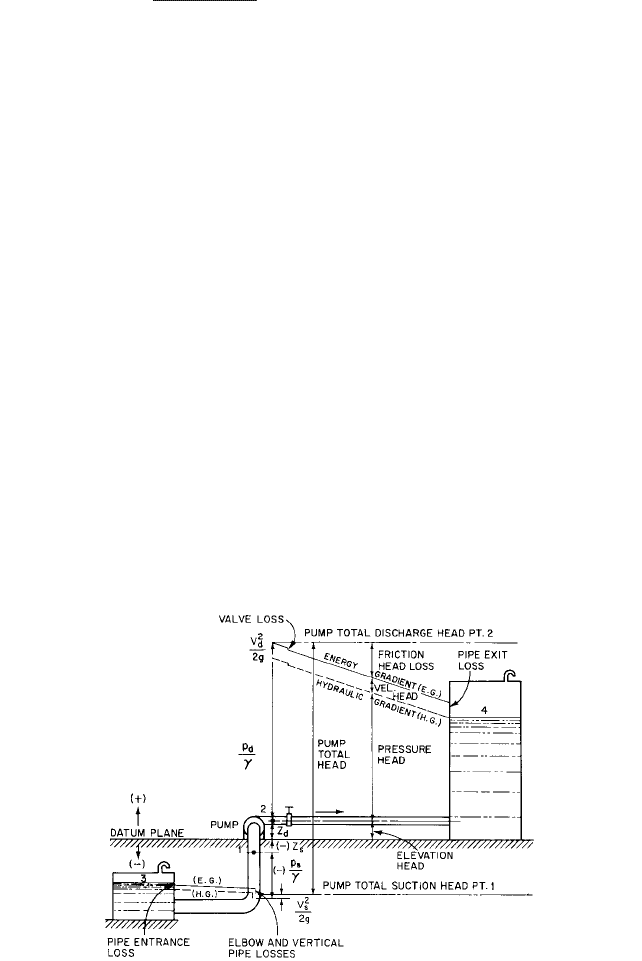
8.12 CHAPTER EIGHT
FIGURE 9 Energy and hydraulic gradients
in SI units
ENERGY AND HYDRAULIC GRADIENT __________________________________
The total energy at any point in a pumping system may be calculated for a particular rate
of flow using Bernoulli’s equation (Eq. 1). If some convenient datum plane is selected and
the total energy, or head, at various locations along the system is plotted to scale, the line
drawn through these points is called the energy gradient. Figure 9 shows the variation in
total energy H measured in feet (meters) from the suction liquid surface point 3 to the dis-
charge liquid surface point 4. A horizontal energy gradient indicates no loss of head.
The line drawn through the sum of the pressure and elevation heads at various points
represents the pressure variation in flow measured above the datum plane. It also repre-
sents the height the liquid would rise in vertical columns relative to the datum plane when
the columns are placed at various locations along pipes having positive pressure anywhere
in the system. This line, shown dotted in Figure 9, is called the hydraulic gradient. The dif-
ference between the energy gradient line and the hydraulic gradient line is the velocity
head in the pipe at that point.
The pump total head is the algebraic difference between the total energy at the pump
discharge (point 2) and the total energy at the pump suction (point 1).
SYSTEM-HEAD CURVES ______________________________________________
A pumping system may consist of piping, valves, fittings, open channels, vessels, nozzles,
weirs, meters, process equipment, and other liquid-handling conduits through which flow
is required for various reasons. When a particular system is being analyzed for the pur-
103.2 11.522 8.53 113.3 N
#
m>N, or m
TH a0
0.102 689.5
0.8
15.24b 10 0 1.522 10.91 7.622

8.1 PUMPING SYSTEMS AND SYSTEM-HEAD CURRVES 8.13
FIGURE 10 Construction of system total-head curve
pose of selecting a pump or pumps, the resistance to flow of the liquid through these var-
ious components must be calculated. It will be explained in more detail later in this sec-
tion that the resistance increases with flow at a rate approximately equal to the square of
the flow through the system. In addition to overcoming flow resistance, it may be neces-
sary to add head to raise the liquid from suction level to a higher discharge level. In some
systems the pressure at the discharge liquid surface may be higher than the pressure at
the suction liquid surface, a condition that requires more pumping head. The latter two
heads are fixed system heads, as they do not vary with rate of flow. Fixed system heads can
also be negative, as would be the case if the discharge level elevation or the pressure above
that level were lower than suction elevation or pressure. Fixed system heads are also
called static heads.
A system-head curve is a plot of total system resistance, variable plus fixed, for various
flow rates. It has many uses in centrifugal pump applications. It is preferable to express
system head in feet (meters) rather than in pressure units because centrifugal pumps are
rated in feet (meters), as previously explained. System-head curves usually show flow in
gallons per minute, but when large quantities are involved, the units of cubic feet per sec-
ond or million gallons per day are used.Although the standard SI units for volumetric flow
are cubic meters per second, the units of cubic meters per hour are more common.
When the system head is required for several flows or when the pump flow is to be
determined, a system-head curve is constructed using the following procedure. Define the
pumping system and its length. Calculate (or measure) the fixed system head, which is the
net change in total energy from the beginning to the end of the system due to elevation or
pressure head differences.An increase in head in the direction of flow is a positive quantity.
Next, calculate, for several flow rates, the variable system total head loss through all pip-
ing, valves fittings, and equipment in the system. As an example, see Figure 10, in which
the pumping system is defined as starting at point 1 and ending at point 2. The fixed sys-
tem head is the net change in total energy. The total head at point 1 is p
s
/g, and that at point
2 is p
d
/g Z.The pressure and liquid levels do not vary with flow. The variable system head
is pipe friction (including valves and fittings).The fixed head and variable heads for several
flow rates are added together, resulting in a curve of total system head versus flow.
The flow produced by a centrifugal pump varies with the system head, whereas the flow
of a positive displacement pump is independent of the system head. By superimposing the
head-capacity characteristic curve of a centrifugal pump on a system-head curve, as shown
in Figure 10, the flow of a pump can be determined.The curves will intersect at the flow rate
of the pump, as this is the point at which the pump head is equal to the required system
